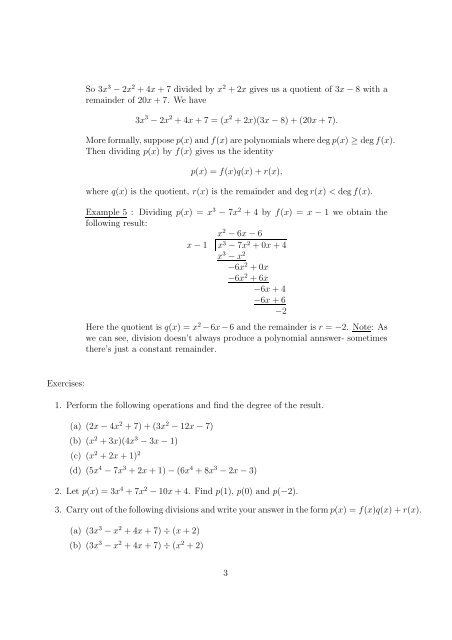Worksheet 4.7 Polynomials
Worksheet 4.7 Polynomials
Worksheet 4.7 Polynomials
You also want an ePaper? Increase the reach of your titles
YUMPU automatically turns print PDFs into web optimized ePapers that Google loves.
Exercises:<br />
So 3x 3 − 2x 2 + 4x + 7 divided by x 2 + 2x gives us a quotient of 3x − 8 with a<br />
remainder of 20x + 7. We have<br />
3x 3 − 2x 2 + 4x + 7 = (x 2 + 2x)(3x − 8) + (20x + 7).<br />
More formally, suppose p(x) and f(x) are polynomials where deg p(x) ≥ deg f(x).<br />
Then dividing p(x) by f(x) gives us the identity<br />
p(x) = f(x)q(x) + r(x),<br />
where q(x) is the quotient, r(x) is the remainder and deg r(x) < deg f(x).<br />
Example 5 : Dividing p(x) = x 3 − 7x 2 + 4 by f(x) = x − 1 we obtain the<br />
following result:<br />
x 2 − 6x − 6<br />
x − 1 x 3 − 7x 2 + 0x + 4<br />
x 3 − x 2<br />
−6x 2 + 0x<br />
−6x 2 + 6x<br />
−6x + 4<br />
−6x + 6<br />
−2<br />
Here the quotient is q(x) = x 2 − 6x − 6 and the remainder is r = −2. Note: As<br />
we can see, division doesn’t always produce a polynomial annswer- sometimes<br />
there’s just a constant remainder.<br />
1. Perform the following operations and find the degree of the result.<br />
(a) (2x − 4x 2 + 7) + (3x 2 − 12x − 7)<br />
(b) (x 2 + 3x)(4x 3 − 3x − 1)<br />
(c) (x 2 + 2x + 1) 2<br />
(d) (5x 4 − 7x 3 + 2x + 1) − (6x 4 + 8x 3 − 2x − 3)<br />
2. Let p(x) = 3x 4 + 7x 2 − 10x + 4. Find p(1), p(0) and p(−2).<br />
3. Carry out of the following divisions and write your answer in the form p(x) = f(x)q(x) + r(x).<br />
(a) (3x 3 − x 2 + 4x + 7) ÷ (x + 2)<br />
(b) (3x 3 − x 2 + 4x + 7) ÷ (x 2 + 2)<br />
3
















